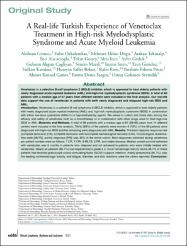A real-life Turkish experience of venetoclax treatment in high-risk myelodysplastic syndrome and acute myeloid leukemia

Göster/
Erişim
info:eu-repo/semantics/embargoedAccessTarih
2021Yazar
Gemici, AliihsanÖzkalemkaş, Fahir
Doğu, Mehmet Hilmi
Tekinalp, Atakan
Alacacıoğlu, İnci
Güney, Tekin
İnce, İdris
Gedük, Ayfer
Akgün Çağlıyan, Gülsüm
Maral, Senem
Serin, İstemi
Gündüz, Eren
Karakuş, Volkan
Beköz, Hüseyin Saffet
Eren, Rafet
Pınar, İbrahim Ethem
Güneş, Ahmet Kürşad
Sargın, Fatma Deniz
Sevindik, Ömür Gökmen
Üst veri
Tüm öğe kaydını gösterKünye
Gemici, A., Özkalemkaş, F., Doğu, M. H., Tekinalp, A., Alacacıoğlu, İ., Güney, T. ... Sevindik, Ö. G. (2021). A real-life Turkish experience of venetoclax treatment in high-risk myelodysplastic syndrome and acute myeloid leukemia. Clinical Lymphoma, Myeloma & Leukemia, 21(8), E686-E692. https://dx.doi.org/10.1016/j.clml.2021.04.004Özet
Venetoclax is a selective B-cell lymphoma 2 (BCL2) inhibitor, which is approved to treat elderly patients with newly diagnosed acute myeloid leukemia (AML) and high-risk myelodysplastic syndrome (MDS). A total of 60 patients with a median age of 67 years from different centers were included in the final analysis. Our real-life data support the use of venetoclax in patients with both newly diagnosed and relapsed high-risk MDS and AML.
Introduction: Venetoclax is a selective B-cell lymphoma 2 (BCL2) inhibitor, which is approved to treat elderly patients with newly diagnosed acute myeloid leukemia (AML) and high-risk myelodysplastic syndrome (MDS) in combination with either low-dose cytarabine (ARA-C) or hypomethylating agents. We aimed to collect and share data among the efficacy and safety of venetoclax both as a monotherapy or in combination with other drugs used to treat high-risk MDS or AML. Materials and Methods: A total of 60 patients with a median age of 67 (30-83) years from 14 different centers were included in the final analysis. Thirty (50%) of the patients were women; 6 (10%) of the 60 patients were diagnosed with high-risk MDS and the remaining were diagnosed with AML. Results: The best objective response rate (complete remission [CR], complete remission with incomplete hematological recovery (CRi), morphological leukemia-free state [MLFS], partial response [PR]) was 35% in the entire cohort. Best responses achieved during venetoclax per patient number were as follows: 7 CR, 1 CRi, 8 MLFS, 5 PR, and stable disease. Median overall survival achieved with venetoclax was 5 months in patients who relapsed and not achieved in patients who were initially treated with venetoclax. Nearly all patients (86.7%) had experienced a grade 2 or more hematologic toxicity. Some 36.7% of these patients had received granulocyte colony stimulating factor (GCSF) support. Infection, mainly pneumonia (26.7%), was the leading nonhematologic toxicity, and fatigue, diarrhea, and skin reactions were the others reported. Conclusion: Our real-life data support the use of venetoclax in patients with both newly diagnosed and relapsed high-risk MDS and AML.
WoS Q Kategorisi
Q3Scopus Q Kategorisi
Q2Kaynak
Clinical Lymphoma, Myeloma & LeukemiaCilt
21Sayı
8Koleksiyonlar
- Makale Koleksiyonu [3777]
- PubMed İndeksli Yayınlar Koleksiyonu [4230]
- Scopus İndeksli Yayınlar Koleksiyonu [6574]
- WoS İndeksli Yayınlar Koleksiyonu [6631]

















